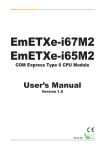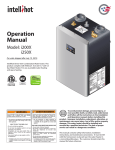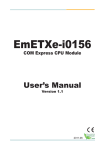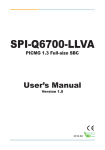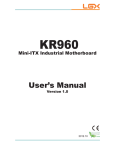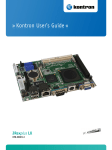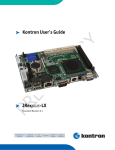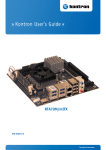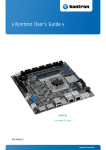Download COM-652E
Transcript
85 COM-652E Wide Range Temperature COM Express Type 2 CPU Module User’s Manual Version 1.0 85 Copyright®2012 All Rights Reserved. 2012.08 This page is intentionally left blank. Index Contents Chapter 1 - Introduction.......................................................1 1.1 Copyright Notice............................................................................2 1.2 Declaration of Conformity............................................................2 1.3 About This User’s Manual............................................................4 1.4 Warning..........................................................................................4 1.5 Replacing the Lithium Battery.....................................................4 1.6 Technical Support.........................................................................4 1.7 Warranty.........................................................................................5 1.8 Packing List...................................................................................6 1.9 Ordering Information.....................................................................6 1.10 Specifications..............................................................................7 1.11 Board Dimensions.......................................................................8 Chapter 2 - Installation.........................................................9 2.1 2.2 2.3 2.4 2.5 2.6 What is “COM Express”?...........................................................10 Block Diagram ............................................................................12 Connectors..................................................................................13 COM Express AB Connector (bottom side)..............................14 COM Express CD Connector (bottom side).............................15 The Installation Paths of CD Driver...........................................16 Chapter 3 - BIOS.................................................................17 3.1 BIOS Main Setup.........................................................................18 3.2 Advanced Settings......................................................................19 3.2.1 PCI Subsystem Settings.......................................20 3.2.2 ACPI Settings........................................................21 3.2.3 CPU Configuration................................................22 3.2.4 IDE Configuration.................................................23 3.2.5 USB Configuration................................................24 3.2.6 Super IO Configuration........................................26 3.2.7 F71869 H/W Monitor..............................................29 -I- Index 3.3 Chipset.........................................................................................30 3.3.1 Host Bridge Parameters.......................................31 3.3.2 SB Configuration..................................................35 3.4 Boot Settings...............................................................................40 3.5 Security........................................................................................41 3.6 Save & Exit...................................................................................43 3.7 AMI BIOS Checkpoints................................................................44 3.7.1 Checkpoint Ranges..............................................44 3.7.2 Standard Checkpoints..........................................45 Appendix.............................................................................................53 Appendix A: I/O Port Address Map..................................................54 Appendix B: Interrupt Request Lines (IRQ)....................................57 Appendix C: BIOS Memory Map.......................................................58 Appendix D: Digital I/O Setting........................................................60 - II - Introduction 1 Chapter 1 Introduction Chapter 1 - Introduction -1- Introduction 1.1 Copyright Notice All Rights Reserved. The information in this document is subject to change without prior notice in order to improve the reliability, design and function. It does not represent a commitment on the part of the manufacturer. Under no circumstances will the manufacturer be liable for any direct, indirect, special, incidental, or consequential damages arising from the use or inability to use the product or documentation, even if advised of the possibility of such damages. This document contains proprietary information protected by copyright. All rights are reserved. No part of this manual may be reproduced by any mechanical, electronic, or other means in any form without prior written permission of the manufacturer. 1.2 Declaration of Conformity CE The CE symbol on your product indicates that it is in compliance with the directives of the Union European (EU). A Certificate of Compliance is available by contacting Technical Support. This product has passed the CE test for environmental specifications when shielded cables are used for external wiring. We recommend the use of shielded cables. This kind of cable is available from ARBOR. Please contact your local supplier for ordering information. This product has passed the CE test for environmental specifications. Test conditions for passing included the equipment being operated within an industrial enclosure. In order to protect the product from being damaged by ESD (Electrostatic Discharge) and EMI leakage, we strongly recommend the use of CE-compliant industrial enclosure products. Warning This is a class A product. In a domestic environment this product may cause radio interference in which case the user may be required to take adequate measures. FCC Class A This device complies with Part 15 of the FCC Rules. Operation is subject to the following two conditions: -2- Introduction (1)This device may not cause harmful interference, and (2)This device must accept any interference received, including interference that may cause undesired operation. NOTE: This equipment has been tested and found to comply with the limits for a Class A digital device, pursuant to Part 15 of the FCC Rules. These limits are designed to provide reasonable protection against harmful interference when the equipment is operated in a commercial environment. This equipment generates, uses, and can radiate radio frequency energy and, if not installed and used in accordance with the instruction manual, may cause harmful interference to radio communications. Operation of this equipment in a residential area is likely to cause harmful interference in which case the user will be required to correct the interference at his own expense. RoHS ARBOR Technology Corp. certifies that all components in its products are in compliance and conform to the European Union’s Restriction of Use of Hazardous Substances in Electrical and Electronic Equipment (RoHS) Directive 2002/95/EC. The above mentioned directive was published on 2/13/2003. The main purpose of the directive is to prohibit the use of lead, mercury, cadmium, hexavalent chromium, polybrominated biphenyls (PBB), and polybrominated diphenyl ethers (PBDE) in electrical and electronic products. Member states of the EU are to enforce by 7/1/2006. ARBOR Technology Corp. hereby states that the listed products do not contain unintentional additions of lead, mercury, hex chrome, PBB or PBDB that exceed a maximum concentration value of 0.1% by weight or for cadmium exceed 0.01% by weight, per homogenous material. Homogenous material is defined as a substance or mixture of substances with uniform composition (such as solders, resins, plating, etc.). Lead-free solder is used for all terminations (Sn(9696.5%), Ag(3.0-3.5%) and Cu(0.5%)). SVHC / REACH To minimize the environmental impact and take more responsibility to the earth we live, Arbor hereby confirms all products comply with the restriction of SVHC (Substances of Very High Concern) in (EC) 1907/2006 (REACH --Registration, Evaluation, Authorization, and Restriction of Chemicals) regulated by the European Union. All substances listed in SVHC < 0.1 % by weight (1000 ppm) -3- Introduction 1.3 About This User’s Manual This user’s manual provides general information and installation instructions about the product. This User’s Manual is intended for experienced users and integrators with hardware knowledge of personal computers. If you are not sure about any description in this booklet. please consult your vendor before further handling. 1.4 Warning Single Board Computers and their components contain very delicate Integrated Circuits (IC). To protect the Single Board Computer and its components against damage from static electricity, you should always follow the following precautions when handling it : 1. Disconnect your Single Board Computer from the power source when you want to work on the inside. 2. Hold the board by the edges and try not to touch the IC chips, leads or circuitry. 3. Use a grounded wrist strap when handling computer components. 4. Place components on a grounded antistatic pad or on the bag that comes with the Single Board Computer, whenever components are separated from the system. 1.5 Replacing the Lithium Battery Incorrect replacement of the lithium battery may lead to a risk of explosion. The lithium battery must be replaced with an identical battery or a battery type recommended by the manufacturer. Do not throw lithium batteries into the trash-can. It must be disposed of in accordance with local regulations concerning special waste. 1.6 Technical Support If you have any technical difficulties, please do not hesitate to call or e-mail our customer service. http://www.arbor.com.tw E-mail:[email protected] -4- Introduction 1.7 Warranty This product is warranted to be in good working order for a period of two years from the date of purchase. Should this product fail to be in good working order at any time during this period, we will, at our option, replace or repair it at no additional charge except as set forth in the following terms. This warranty does not apply to products damaged by misuse, modifications, accident or disaster. Vendor assumes no liability for any damages, lost profits, lost savings or any other incidental or consequential damage resulting from the use, misuse of, or inability to use this product. Vendor will not be liable for any claim made by any other related party. Vendors disclaim all other warranties, either expressed or implied, including but not limited to implied warranties of merchantability and fitness for a particular purpose, with respect to the hardware, the accompanying product’s manual(s) and written materials, and any accompanying hardware. This limited warranty gives you specific legal rights. Return authorization must be obtained from the vendor before returned merchandise will be accepted. Authorization can be obtained by calling or faxing the vendor and requesting a Return Merchandise Authorization (RMA) number. Returned goods should always be accompanied by a clear problem description. -5- Introduction 1.8 Packing List Packing List Before you begin installing your single board, please make sure that the following materials have been shipped: 1 x COM Express CPU Module 1 x Driver CD 1 x Quick Installation Guide If any of the above items is damaged or missing, contact your vendor immediately. 1.9 Ordering Information COM-652E-N26 Intel® Atom™ N2600 1.6GHz COM Express Compact CPU module COM-652E-D25 Intel® Atom™ D2550 1.86GHz COM Express Compact CPU module HS-2503-F1 Heat spreader (95 x 95 x18mm) HS-2503-W1 Heatsink wave type (95 x 95 x 40mm) PBE-1700-F R1.3 COM Express Type 2 evaluation board in ATX form factor w/ F71869 Super IO CBK-04-1700-00 Cable kit 1 x SATA cable 1 x COM port cable 1 x FDD cable 1 x IDE cable -6- Introduction 1.10 Specifications Form Factor COM Express Type 2 CPU Module CPU Soldered onboard Intel® Atom™ N2600 1.6GHz or D2550 1.86GHz processor Chipset Intel® PCH NM10 System Memory 1 x DDR3 SO-DIMM socket, supporting 1066MHz SDRAM up to 4GB (D2550)/ 2GB (N2600) Graphics ●● Integrated Intel® GMA 3650 (Gfx frequency 640MHz) for D2550 processor ●● Integrated Intel® GMA 3600 (Gfx frequency 400MHz) for N2600 processor Display ●● Support Analog RGB ●● LCD: Single Channel 18-bit for N2600 processor/ 24-bit for D2550 processor ●● Support dual independent displays Ethernet controller 1 x Intel® 82583V PCIe Gigabit Ethernet controller BIOS AMI® UEFI BIOS Storage 2 x Serial ATA ports with 300MB/s HDD transfer rate Digital I/O 8-bit programmable Digital Input/Output Universal Serial Bus 8 x USB 2.0 ports Expansion Interface ●● ●● ●● Operating Temp. -40ºC ~ 85ºC (-40ºF ~ 185ºF) Operating Humidity 0 ~ 95% (non-condensing) Watchdog Timer 1~ 255 levels reset Dimension (L x W) 95 x 95 mm (3.7” x 3.7”) 2 x PCIex1 lanes 4 x PCI masters SPI and LPC (Low Pin Count) interfaces -7- Introduction 1.11 Board Dimensions 2.70 95.00 91.00 44.97 NM10 SB Cedar View D 45.35 -8- 91.00 95.00 80.00 69.32 0 4.00 4.00 0 Unit: mm Installation 2 Chapter 2 Installation Chapter 2 - Installation -9- Installation 2.1 What is “COM Express”? With more and more demands on small and embedded industrial boards, a multi-functioned COM (Computer-on-Module) is the great one of the solutions. COM Express, board-to-board connectors consist of two rows of 220 pins each. Row AB, which is required, provides pins for PCI Express, SATA, LVDS, LCD channel, LPC bus, system and power management, VGA, LAN, and power and ground interfaces. Row CD, which is optional, provides SDVO and legacy PCI and IDE signals next to additional PCI Express, LAN and power and ground signals. By the way, the target markets of COM will be focused on: ● Retail & Advertising ● Medical ● Test & Measurement ● Gaming & Entertainment ● Industrial & Automation ● Military & Government ● Security - 10 - Installation COM Express supports seven pin-out Type applying to Basic and Extended form factors: Module Type 1 and 10 support single connector with two rows of pins (220 pins) Module Type 2, 3, 4, 5 and 6 support two connectors with four rows of pins (440 pins) Connector placement and most mounting holes have transparency between Form Factors. The differences among the Module Type 2 and COM-652E are summarized in table below: Module Type Standard Type 2 COM-652E 2 2 Connector Rows A, B, C, D A, B, C, D PCIe Lanes (Max) 22 2 PEG (Max) Yes No PCI Bus Yes Yes PATA - IDE Yes No Serial ATA (Max) 4 2 LAN (Max) 1 1 No No 2 0 Connectors Serial Ports Muxed SDVO (Max) - 11 - Installation 2.2 Block Diagram Single Channel DDR3 800/ 1067MHz Intel® Atom N2600 at 1.60GHz/ D2550 at 1.86GHz 1 x SO-DIMM socket Analog R.G.B. 18/24-bit Single Channel LVDS Connector AB DMIx2 for Cedarview-M DMIx4 for Cedarview-D HD Audio Link SMBus SMBus 1xPCIex1 NM10 Express Chipset PCH Intel 82583V GbE controller 8-bit Digital I/O GbE LAN1 8 x USB ports LPC I/F 2 x Serial ATA Ports 2 x PCIex1 SPI Bus SPI Bus 1 x PCI master SPI BIOS IT 8209R PCI Arbiter 1 x PCI master - 12 - 3 x PCI Masters Connector CD Intel® Fintek F75111 Installation 2.3 Connectors Top side SO-DIMM socket NM10 SB Cedar View D Bottom side COM Express AB Connector COM Express CD Connector COM Express CD Connector COM Express AB Connector - 13 - Installation 2.4 COM Express AB Connector (bottom side) B1 B2 B3 B4 B5 B6 B7 B8 B9 B10 B11 B12 B13 B14 B15 B16 B17 B18 B19 B20 B21 B22 B23 B24 B25 B26 B27 B28 B29 B30 B31 B32 B33 B34 B35 B36 B37 B38 B39 B40 B41 B42 B43 B44 B45 B46 B47 B48 B49 B50 B51 B52 B53 B54 B55 GND GND GBE0_MDI3GBE0_ACT# GBE0_MDI3+ LPC_FRAME# GBE0_LINK100# LPC_AD0 GBE0_LINK1000# LPC_AD1 GBE0_MDI2LPC_AD2 GBE0_MDI2+ LPC_AD3 GBE0_LINK# LPC_DRQ0# GBE0_MDI1LPC_DRQ1# GBE0_MDI1+ LPC_CLK GND GND GBE0_MDI0PWRBTN# GBE0_MDI0+ SMB_CK GBE0_CTREF SMB_DAT SUS_S3# SMB_ALERT# SATA0_TX+ SATA1_TX+ SATA0_TXSATA1_TXSUS_S4# SUS_STAT# SATA0_RX+ SATA1_RX+ SATA0_RXSATA1_RXGND GND N/C N/C N/C N/C SUS_S5# PWR_OK N/C N/C N/C N/C BATLOW# WDT ATA_ACT# AC_SDIN2 AC_SYNC AC_SDIN1 AC_RST# AC_SDIN0 GND GND AC_BITCLK SPKR AC_SDOUT I2C_CK BIOS_DISABLE0# I2C_DAT THRMTRIP# THRM# USB6USB7USB6+ USB7+ USB_6_7_OC# USB_4_5_OC# USB4USB5USB4+ USB5+ GND GND USB2USB3USB2+ USB3+ USB_2_3_OC# USB_0_1_OC# USB0USB1USB0+ USB1+ VCC_RTC EXCD1_PERST# EXCD1_CPPE# EXCD0_PERST# EXCD0_CPPE# SYS_RESET# LPC_SERIRQ CB_RESET# GND GND N/C N/C N/C N/C GPI0 GPO1 N/C N/C A1 A2 A3 A4 A5 A6 A7 A8 A9 A10 A11 A12 A13 A14 A15 A16 A17 A18 A19 A20 A21 A22 A23 A24 A25 A26 A27 A28 A29 A30 A31 A32 A33 A34 A35 A36 A37 A38 A39 A40 A41 A42 A43 A44 A45 A46 A47 A48 A49 A50 A51 A52 A53 A54 A55 B56 B57 B58 B59 B60 B61 B62 B63 B64 B65 B66 B67 B68 B69 B70 B71 B72 B73 B74 B75 B76 B77 B78 B79 B80 B81 B82 B83 B84 B85 B86 B87 B88 B89 B90 B91 B92 B93 B94 B95 B96 B97 B98 B99 B100 B101 B102 B103 B104 B105 B106 B107 B108 B109 B110 - 14 - N/C N/C GND GND N/C N/C N/C N/C GND GND N/C N/C N/C N/C GPI1 GPO3 PCIE_TX1+ PCIE_RX1+ PCIE_TX1PCIE_RX1GND WAKE0# GPI2 WAKE1# PCIE_TX0+ PCIE_RX0+ PCIE_TX0PCIE_RX0GND GND LVDS_A0+ N/C LVDS_A0N/C LVDS_A1+ N/C LVDS_A1N/C LVDS_A2+ N/C LVDS_A2N/C LVDS_VDD_EN N/C LVDS_A3+ N/C LVDS_A3LVDS_BKLT_EN GND GND LVDS_A_CK+ N/C LVDS_A_CKN/C CKLVDS_BKLT_CTRL LVDS_I2C_CK LVDS_I2C_DAT VCC_5V_SBY GPI3 VCC_5V_SBY KBD_RST# VCC_5V_SBY KBD_A20GATE VCC_5V_SBY BIOS_DISABLE1# PCIE0_CK_REF+ PCIE0_CK_REFVGA_RED GND GND RSVD B91 VGA_GRN RSVD VGA_BLU GPO0 VGA_HSYNC RSVD VGA_VSYNC RSVD VGA_I2C_CK GND VGA_I2C_DAT VCC_12V N/C VCC_12V N/C VCC_12V N/C GND GND VCC_12V VCC_12V VCC_12V VCC_12V VCC_12V VCC_12V VCC_12V VCC_12V VCC_12V VCC_12V VCC_12V VCC_12V VCC_12V VCC_12V VCC_12V VCC_12V VCC_12V VCC_12V GND GND A56 A57 A58 A59 A60 A61 A62 A63 A64 A65 A66 A67 A68 A69 A70 A71 A72 A73 A74 A75 A76 A77 A78 A79 A80 A81 A82 A83 A84 A85 A86 A87 A88 A89 A90 A91 A92 A93 A94 A95 A96 A97 A98 A99 A100 A101 A102 A103 A104 A105 A106 A107 A108 A109 A110 Installation 2.5 COM Express CD Connector (bottom side) D1 D2 D3 D4 D5 D6 D7 D8 D9 D10 D11 D12 D13 D14 D15 D16 D17 D18 D19 D20 D21 D22 D23 D24 D25 D26 D27 D28 D29 D30 D31 D32 D33 D34 D35 D36 D37 D38 D39 D40 D41 D42 D43 D44 D45 D46 D47 D48 D49 D50 D51 D52 D53 D54 D55 GND N/C N/C N/C N/C N/C N/C N/C N/C N/C GND N/C N/C N/C N/C N/C N/C N/C PCI_GNT3# PCI_REQ3# GND PCI_AD1 PCI_AD3 PCI_AD5 PCI_AD7 PCI_C/BE0# PCI_AD9 PCI_AD11 PCI_AD13 PCI_AD15 GND PCI_PAR PCI_SERR# PCI_STOP# PCI_TRDY# PCI_FRAME# PCI_AD16 PCI_AD18 PCI_AD20 PCI_AD22 GND PCI_AD24 PCI_AD26 PCI_AD28 PCI_AD30 PCI_IRQC# PCI_IRQD# PCI_CLKRUN# PCI_M66EN PCI_CLK GND N/C N/C N/C N/C GND N/C N/C N/C N/C N/C N/C N/C N/C N/C GND N/C N/C N/C PCI_PME# PCI_GNT2# PCI_REQ2# PCI_GNT1# PCI_REQ1# PCI_GNT0# GND PCI_REQ0# PCI_RESET# PCI_AD0 PCI_AD2 PCI_AD4 PCI_AD6 PCI_AD8 PCI_AD10 PCI_AD12 GND PCI_AD14 PCI_C/BE1# PCI_PERR# PCI_LOCK# PCI_DEVSEL# PCI_IRDY# PCI_C/BE2# PCI_AD17 PCI_AD19 GND PCI_AD21 PCI_AD23 PCI_C/BE3# PCI_AD25 PCI_AD27 PCI_AD29 PCI_AD31 PCI_IRQA# PCI_IRQB# GND (FIXED) N/C N/C TYPE0# N/C C1 C2 C3 C4 C5 C6 C7 C8 C9 C10 C11 C12 C13 C14 C15 C16 C17 C18 C19 C20 C21 C22 C23 C24 C25 C26 C27 C28 C29 C30 C31 C32 C33 C34 C35 C36 C37 C38 C39 C40 C41 C42 C43 C44 C45 C46 C47 C48 C49 C50 C51 C52 C53 C54 C55 D56 D57 D58 D59 D60 D61 D62 D63 D64 D65 D66 D67 D68 D69 D70 D71 D72 D73 D74 D75 D76 D77 D78 D79 D80 D81 D82 D83 D84 D85 D86 D87 D88 D89 D90 D91 D92 D93 D94 D95 D96 D97 D98 D99 D100 D101 D102 D103 D104 D105 D106 D107 D108 D109 D110 - 15 - N/C TYPE2# N/C N/C GND N/C N/C RSVD RSVD N/C N/C GND N/C N/C GND N/C N/C SDVO_CLK N/C N/C GND N/C N/C N/C GND N/C N/C RSVD GND N/C N/C GND N/C N/C GND N/C N/C GND N/C N/C GND N/C N/C N/C GND N/C N/C GND VCC_12V VCC_12V VCC_12V VCC_12V VCC_12V VCC_12V GND N/C TYPE1# N/C N/C GND N/C N/C RSVD RSVD N/C N/C RSVD N/C N/C GND N/C N/C SDVO_DATA N/C N/C GND RSVD N/C N/C GND N/C N/C RSVD GND N/C N/C GND N/C N/C GND N/C N/C GND N/C N/C GND RSVD N/C N/C GND N/C N/C GND VCC_12V VCC_12V VCC_12V VCC_12V VCC_12V VCC_12V GND C56 C57 C58 C59 C60 C61 C62 C63 C64 C65 C66 C67 C68 C69 C70 C71 C72 C73 C74 C75 C76 C77 C78 C79 C80 C81 C82 C83 C84 C85 C86 C87 C88 C89 C90 C91 C92 C93 C94 C95 C96 C97 C98 C99 C100 C101 C102 C103 C104 C105 C106 C107 C108 C109 C110 Installation 2.6 The Installation Paths of CD Driver Windows 7 Driver Path Chipset \EmETXe-i250x\CHIPSET\WIN7 LAN \EmETXe-i250x\ETHERNET VGA \EmETXe-i250x\GRAPHICS Audio \EmETXe-i250x\AUDIO - 16 - BIOS 3 Chapter 3 BIOS Chapter 3 - BIOS - 17 - BIOS 3.1 BIOS Main Setup The AMI BIOS provides a setup utility program for specifying the system configurations and settings which are stored in the BIOS ROM of the system. When you turn on the computer, the AMI BIOS is immediately activated. After you have entered the setup utility, use the left/right arrow keys to highlight a particular configuration screen from the top menu bar or use the down arrow key to access and configure the information below. NOTE: In order to increase system stability and performance, our engineering staff are constantly improving the BIOS menu. The BIOS setup screens and descriptions illustrated in this manual are for your reference only, and may not completely match what you see on your screen. BIOS Information Display the BIOS information. - 18 - BIOS System Date Set the system date. Note that the ‘Day’ automatically changes when you set the date. The date format is: Day : Sun to Sat Month : 1 to 12 Date : 1 to 31 Year : 1999 to 2099 System Time Set the system time. The time format is: Hour : 00 to 23 Minute : 00 to 59 Second : 00 to 59 3.2 Advanced Settings Legacy OpROM Support Launch PXE OpROM Enable or disable the boot option for legacy network devices. Launch Storage OpROM Enable or Disable Boot Option for Legacy Mass Storage Devices with Option ROM. - 19 - BIOS 3.2.1 PCI Subsystem Settings PCI ROM Priority In case of multiple Option ROMs (Legacy and EFI Compatible), specifies what PCI Option ROM to launch. PCI Latency Timer Value to be programmed into PCI Latency Timer Register. VGA Palette Snnop Enables or Disabled VGA Palette Registers Snooping. PERR# Generation Enables or Disabled PCI Device to Generate PERR#. SERR# Generation Enables or Disabled PCI Device to Generate SERR#. - 20 - BIOS 3.2.2 ACPI Settings Enable ACPI Auto Configuration Enables or disables BIOS ACPI Auto Configuration. Enable Hibernation Enable or disable System ability to Hibernation (OS/S4 Sleep State). This option may be not effective with some OS. ACPI Sleep State Select the highest ACPI sleep state the system will enter when the SUSPEND button is pressed. The choice: Suspend Disabled, S1 (CPU Stop Clock), S3 (Suspend to RAM) Lock Legacy Resources Enables or disables Lock of Legacy Resources. Power-Supply Type Set power-supply type. The choice: AT, ATX - 21 - BIOS 3.2.3 CPU Configuration The CPU Configuration setup screen varies depending on the installed processor. Hyper-threading This item is used to enable or disable the processor’s Hyper-threading feature. Enabled for Windows XP and Linux (OS optimized for Hyper-threading Technology) and disabled for other OS (OS not optimized for Hyper-threading Technology). When disabled, only one thread per enabled core is enabled. Execute Disable Bit XD can prevent certain classes of malicious buffer overflow attacks when conbined with a supporting OS (Windows Server 2003 SP1, Windows XP SP2, SuSE Linux 9.2, RedHat Enterprise 3, update 3.) Limit CPUID Maximum Disabled for Windows XP. - 22 - BIOS 3.2.4 IDE Configuration It allows you to select the operation mode for SATA controller. SATA Controller(s) Enable or disable SATA devices. SATA Mode Selection The choice: Disable; IDE (Default), AHCI (not available in EmETXe-i65M2), RAID IDE: Set the Serial ATA drives as Parallel ATA storage devices. AHCI: Allow the Serial ATA devices to use AHCI (Advanced Host Controller Interface). RAID: Create RAID or Intel Matrix Storage configuration on Serial ATA devices. - 23 - BIOS 3.2.5 USB Configuration Legacy USB Support Enable support for legacy USB. AUTO option disables legacy support if no USB devices are connected. The choice: Enabled (Default); Auto; Disabled EHCI Hand-off Allow you to enable support for operating systems without an EHCI hand-off feature. Do not disable the BIOS EHCI Hand-Off option if you are running a Windows® operating system with USB device. The choice: Enabled (Default); Disabled USB transfer time-out The time-out value for Control, Bulk, and Interrupt transfers. Default setting: 20 sec Device reset time-out USB mass storage device Start Unit command time-out. Default setting: 20 sec - 24 - BIOS Device power-up delay Maximum time the device will take before it properly reports itself to the host controller. ‘Auto’ uses default value: for a Root port it is 100ms, for a Hub port the delay is taken from hub descriptor. The choice: Auto (Default); Manual - 25 - BIOS 3.2.6 Super IO Configuration You can use this item to set up or change the Super IO configuration for parallel ports and serial ports. Power On After Power Failure Specify what state to go to when power is re-applied after a power failure. Power On by modem Function Enables or Disables the Power On by modem fuction. - 26 - BIOS Serial Port 1~2 Configuration Serial Port Use the Serial port option to enable or disable the serial port. The choice: Enabled, Disabled Change Settings Use the Change Settings option to change the serial port’s IO port address and interrupt address. The choice: Auto IO=3F8h; IRQ=4, IO=3F8h; IRQ=3,4,5,6,7,10,11,12 IO=2F8h; IRQ=3,4,5,6,7,10,11,12 IO=3E8h; IRQ=3,4,5,6,7,10,11,12 IO=2E8h; IRQ=3,4,5,6,7,10,11,12 - 27 - BIOS Parallel Port Configuration Parallel Port Configuration This item allows you to enable/disable Parallel Port (LPT/LPTE). Change Settings Use the Change Settings option to change the parallel port’s IO port address and interrupt address. The choice: Auto IO=378h; IRQ=5, IO=378h; IRO=5,6,7,10,11,12, IO=378h; IRQ=5,6,7,10,11,12, IO=278h; IRQ=5,6,7,10,11,12, IO=38Ch; IRQ=5,6,7,10,11,12, Device Mode The choice: Standard Parallel Port Mode, EPP Mode, ECP Mode, EPP Mode & ECP Mode. - 28 - BIOS 3.2.7 F71869 H/W Monitor PC Health Status The hardware monitor menu shows the operating temperature and system voltages of CPU module. - 29 - BIOS 3.3 Chipset This section allows you to configure and improve your system; also, set up some system features according to your preference. - 30 - BIOS 3.3.1 Host Bridge Parameters Memory Frequency and Timing - 31 - BIOS MRC Fast Boot Enable or disable MRC fast boot. Dyn SR Enable or disable Dyn SR. - 32 - BIOS Intel IGD Configuration Auto Disable IGD Auto disable IGD upon external GFX detected. IFGX - Boot Type Select the Video Device which will be activated during POST. This has no effect if external graphics present. LCD Panel Type Select LCD panel used by Internal Graphics Device by selecting the appropriate setup item: VBIOS Default, 640x480 LVDS ~ 2048x1536 LVDS. Panel Scaling Select the LCD panel scaling option used by the Internal Graphics Device: Auto, Off, Force Scaling. Backlight Control The choice: PWM Inverted (Default), PWM Normal, GMBus Inverted and GMBus Normal. - 33 - BIOS ISD Clock Source ISD clock selection. Fixed Graphics Memory Size Configure fixed Graphics memory size. ALS Support The choice: Enabled, Disabled. Backlight Control Support Backlight control configuration. BIA The choice: VBIOS Default, Disabled and Level 1/2/3/4/5. - 34 - BIOS 3.3.2 SB Configuration DMI Link ASPM Control The control of Active State Power Management on both NB side and SB side of the DMI Link. PCI-Exp. High Priority port Enables or Disables PCI-Exp. High Priority port. PCIE Card0/1 Enables or Disables PCIE Card0/1. High Precision TImer Enables or Disables High Precision Timer. SLP_S4 Assertion Width Select a minimum assertion width of the SLP_S4# signal. The choice: 1-2 Seconds, 2-3 Seconds, 3-4 Seconds, 4-5 Seconds SPI ROM Control Enables or Disables SPI ROM Control. - 35 - BIOS Select USB Mode Select USB mode to control USB port. UHCI1~4 Control the USB UHCI (USB 1.1) functions. Disable from highest to lowest controller. USB 2.0 (EHCI) Support Enable or Disable USB 2.0 (EHCI). LAN controller Enable or Disable OnChip NIC Controller. SMBus controller Enable or Disable SMBus controller. SIRQ Logic Enable or Disable SIRQ logic. SIRQ Mode SIRQ Mode selection. - 36 - BIOS TPT Deviced Enable/ Disable Intel(R) IO Controller Hub (TPT) devices. Azalia Controller Control detection of the Azalia device. Disabled = Azalia will be unconditionally disabled. AH Audio = Azalia will be enabled if present, disabled otherwise. Azalia PME Enable Enable or Disable Power Management capability of Audio Controller. Azalia Vcp Enable Azalia supports 1 external VC, which, when enabled, overrides ICH VCp settings. - 37 - BIOS PCI Express Root Port 0~5 PCI Express Root Port 0~5 Control the PCI Express Root Port. ASPM Support Set the ASPM Level to Disabled, L0s, L1, L0sL1, Auto Force L0 - Force all links to L0 State AUTO - BIOS auto configuration DISABLE - Disable ASPM - 38 - BIOS URR Enable or disable PCI Express Unsupported Request Reporting. FER Enable or disable PCI Express Device Fatal Error Reporting. NFER Enable or disable PCI Express Device Non-Fatal Error Reporting. CER Enable or disable PCI Express Device Correctable Error Reporting. CTO Enable or disable PCI Express Completion Timer TO. SEFE Enable or disable Root PCI Express System Error on Fatal Error. SENFE Enable or disable Root PCI Express System Error on Non-Fatal Error. SECE Enable or disable Root PCI Express System Error on Correctable Error. PME SCI Enable or disable PCI Express PME SCI. Hot Plug Enable or disable PCI Express Hot Plug. - 39 - BIOS 3.4 Boot Settings The Boot menu items allow you to change the system boot options. Boot Configuration Bootup NumLock State This setting determines whether the Num Lock key should be activated at boot up. Quiet Boot This allows you to select the screen display when the system boots. Fast Boot Enables or disables boot with initialization of a minimal set of devices requered to launch active boot optoin. Has no effect for BBS boot option. Option ROM Messeges Set display mode for Option ROM. Interrupt 19 Capture Enabled: Allows option ROM to trap Int 19. Boot Option Priorities Select the boot sequence of the hard drives. - 40 - BIOS 3.5 Security Administrator Password Use the Administrator Password to set or change a administrator password. ENTER PASSWORD Type the password, up to eight characters in length, and press <Enter>. The password typed now will clear any previously entered password from CMOS memory. You will be asked to confirm the password. Type the password again and press <Enter>. You may also press <ESC> to abort the selection and not enter a password. To disable a password, just press <Enter> when you are prompted to enter the password. A message will confirm the password will be disabled. Once the password is disabled, the system will boot and you can enter Setup freely. PASSWORD DISABLED When a password has been enabled, you will be prompted to enter it every time you try to enter Setup. This prevents an unauthorized person from - 41 - BIOS changing any part of your system configuration. Additionally, when a password is enabled, you can also require the BIOS to request a password every time your system is rebooted. This would prevent unauthorized use of your computer. You can determine when the password is required within the BIOS Features Setup Menu and its Security option. If the Security option is set to “System”, the password will be required both at boot and at entry to Setup. If it’s set to “Setup”, prompting only occurs when trying to enter Setup. - 42 - BIOS 3.6 Save & Exit Save Changes and Reset Pressing <Enter> on this item and it asks for confirmation: Save configuration changes and exit setup? Pressing <OK> stores the selection made in the menus in CMOS - a special section of memory that stays on after you turn your system off. The next time you boot your computer, the BIOS configures your system according to the Setup selections stored in CMOS. After saving the values the system is restarted again. Restore Defaults Restore system to factory default. Pressing <Enter> on this item and it asks for confirmation prior to executing this command. Boot Override This group of functions includes a list of tokens, each of them corresponding to one device within the boot order. Select a drive to immediately boot that device regardless of the current boot order. - 43 - BIOS 3.7 AMI BIOS Checkpoints 3.7.1 Checkpoint Ranges Status Code Range Description 0x01 – 0x0B SEC execution 0x0C – 0x0F SEC errors 0x10 – 0x2F PEI execution up to and including memory detection 0x30 – 0x4F PEI execution after memory detection 0x50 – 0x5F PEI errors 0x60 – 0x8F DXE execution up to BDS 0x90 – 0xCF BDS execution 0xD0 – 0xDF DXE errors 0xE0 – 0xE8 S3 Resume (PEI) 0xE9 – 0xEF S3 Resume errors (PEI) 0xF0 – 0xF8 Recovery (PEI) 0xF9 – 0xFF Recovery errors (PEI) - 44 - BIOS 3.7.2 Standard Checkpoints SEC Phase Status Code 0x00 Description Not used Progress Codes 0x01 Power on. Reset type detection (soft/hard). 0x02 AP initialization before microcode loading 0x03 North Bridge initialization before microcode loading 0x04 South Bridge initialization before microcode loading 0x05 OEM initialization before microcode loading 0x06 Microcode loading 0x07 AP initialization after microcode loading 0x08 North Bridge initialization after microcode loading 0x09 South Bridge initialization after microcode loading 0x0A OEM initialization after microcode loading 0x0B Cache initialization SEC Error Codes 0x0C – 0x0D Reserved for future AMI SEC error codes 0x0E Microcode not found 0x0F Microcode not loaded - 45 - BIOS PEI Phase Status Code Description Progress Codes 0x10 PEI Core is started 0x11 Pre-memory CPU initialization is started 0x12 Pre-memory CPU initialization (CPU module specific) 0x13 Pre-memory CPU initialization (CPU module specific) 0x14 Pre-memory CPU initialization (CPU module specific) 0x15 Pre-memory North Bridge initialization is started 0x16 Pre-Memory North Bridge initialization (North Bridge module specific) 0x17 Pre-Memory North Bridge initialization (North Bridge module specific) 0x18 Pre-Memory North Bridge initialization (North Bridge module specific) 0x19 Pre-memory South Bridge initialization is started 0x1A Pre-memory South Bridge initialization (South Bridge module specific) 0x1B Pre-memory South Bridge initialization (South Bridge module specific) 0x1C Pre-memory South Bridge initialization (South Bridge module specific) 0x1D – 0x2A OEM pre-memory initialization codes 0x2B Memory initialization. Serial Presence Detect (SPD) data reading 0x2C Memory initialization. Memory presence detection 0x2D Memory initialization. Programming memory timing information 0x2E Memory initialization. Configuring memory 0x2F Memory initialization (other). 0x30 Reserved for ASL (see ASL Status Codes section below) 0x31 Memory Installed - 46 - BIOS 0x32 CPU post-memory initialization is started 0x33 CPU post-memory initialization. Cache initialization 0x34 CPU post-memory initialization. Application Processor(s) (AP) initialization 0x35 CPU post-memory initialization. Boot Strap Processor (BSP) selection 0x36 CPU post-memory initialization. System Management Mode (SMM) initialization 0x37 Post-Memory North Bridge initialization is started 0x38 Post-Memory North Bridge initialization (North Bridge module specific) 0x39 Post-Memory North Bridge initialization (North Bridge module specific) 0x3A Post-Memory North Bridge initialization (North Bridge module specific) 0x3B Post-Memory South Bridge initialization is started 0x3C Post-Memory South Bridge initialization (South Bridge module specific) 0x3D Post-Memory South Bridge initialization (South Bridge module specific) 0x3E Post-Memory South Bridge initialization (South Bridge module specific) 0x3F-0x4E 0x4F OEM post memory initialization codes DXE IPL is started PEI Error Codes 0x50 Memory initialization error. Invalid memory type or incompatible memory speed 0x51 Memory initialization error. SPD reading has failed 0x52 Memory initialization error. Invalid memory size or memory modules do not match. 0x53 Memory initialization error. No usable memory detected 0x54 Unspecified memory initialization error. - 47 - BIOS 0x55 Memory not installed 0x56 Invalid CPU type or Speed 0x57 CPU mismatch 0x58 CPU self test failed or possible CPU cache error 0x59 CPU micro-code is not found or micro-code update is failed 0x5A Internal CPU error 0x5B reset PPI is not available 0x5C-0x5F Reserved for future AMI error codes S3 Resume Progress Codes 0xE0 S3 Resume is stared (S3 Resume PPI is called by the DXE IPL) 0xE1 S3 Boot Script execution 0xE2 Video repost 0xE3 OS S3 wake vector call 0xE4-0xE7 Reserved for future AMI progress codes S3 Resume Error Codes 0xE8 S3 Resume Failed 0xE9 S3 Resume PPI not Found 0xEA S3 Resume Boot Script Error 0xEB S3 OS Wake Error 0xEC-0xEF Reserved for future AMI error codes Recovery Progress Codes 0xF0 Recovery condition triggered by firmware (Auto recovery) 0xF1 Recovery condition triggered by user (Forced recovery) 0xF2 Recovery process started 0xF3 Recovery firmware image is found 0xF4 Recovery firmware image is loaded 0xF5-0xF7 Reserved for future AMI progress codes Recovery Error Codes 0xF8 Recovery PPI is not available - 48 - BIOS 0xF9 Recovery capsule is not found 0xFA Invalid recovery capsule 0xFB – 0xFF Reserved for future AMI error codes DXE Phase Status Code Description 0x60 DXE Core is started 0x61 NVRAM initialization 0x62 Installation of the South Bridge Runtime Services 0x63 CPU DXE initialization is started 0x64 CPU DXE initialization (CPU module specific) 0x65 CPU DXE initialization (CPU module specific) 0x66 CPU DXE initialization (CPU module specific) 0x67 CPU DXE initialization (CPU module specific) 0x68 PCI host bridge initialization 0x69 North Bridge DXE initialization is started 0x6A North Bridge DXE SMM initialization is started 0x6B North Bridge DXE initialization (North Bridge module specific) 0x6C North Bridge DXE initialization (North Bridge module specific) 0x6D North Bridge DXE initialization (North Bridge module specific) 0x6E North Bridge DXE initialization (North Bridge module specific) 0x6F North Bridge DXE initialization (North Bridge module specific) 0x70 South Bridge DXE initialization is started 0x71 South Bridge DXE SMM initialization is started 0x72 South Bridge devices initialization 0x73 South Bridge DXE Initialization (South Bridge module specific) - 49 - BIOS 0x74 South Bridge DXE Initialization (South Bridge module specific) 0x75 South Bridge DXE Initialization (South Bridge module specific) 0x76 South Bridge DXE Initialization (South Bridge module specific) 0x77 South Bridge DXE Initialization (South Bridge module specific) 0x78 ACPI module initialization 0x79 CSM initialization 0x7A – 0x7F Reserved for future AMI DXE codes 0x80 – 0x8F OEM DXE initialization codes 0x90 Boot Device Selection (BDS) phase is started 0x91 Driver connecting is started 0x92 PCI Bus initialization is started 0x93 PCI Bus Hot Plug Controller Initialization 0x94 PCI Bus Enumeration 0x95 PCI Bus Request Resources 0x96 PCI Bus Assign Resources 0x97 Console Output devices connect 0x98 Console input devices connect 0x99 Super IO Initialization 0x9A USB initialization is started 0x9B USB Reset 0x9C USB Detect 0x9D USB Enable 0x9E – 0x9F Reserved for future AMI codes 0xA0 IDE initialization is started 0xA1 IDE Reset 0xA2 IDE Detect 0xA3 IDE Enable - 50 - BIOS 0xA4 SCSI initialization is started 0xA5 SCSI Reset 0xA6 SCSI Detect 0xA7 SCSI Enable 0xA8 Setup Verifying Password 0xA9 Start of Setup 0xAA Reserved for ASL (see ASL Status Codes section below) 0xAB Setup Input Wait 0xAC Reserved for ASL (see ASL Status Codes section below) 0xAD Ready To Boot event 0xAE Legacy Boot event 0xAF Exit Boot Services event 0xB0 Runtime Set Virtual Address MAP Begin 0xB1 Runtime Set Virtual Address MAP End 0xB2 Legacy Option ROM Initialization 0xB3 System Reset 0xB4 USB hot plug 0xB5 PCI bus hot plug 0xB6 Clean-up of NVRAM 0xB7 Configuration Reset (reset of NVRAM settings) 0xB8 – 0xBF Reserved for future AMI codes 0xC0 – 0xCF OEM BDS initialization codes DXE Error Codes 0xD0 CPU initialization error 0xD1 North Bridge initialization error 0xD2 South Bridge initialization error 0xD3 Some of the Architectural Protocols are not available 0xD4 PCI resource allocation error. Out of Resources 0xD5 No Space for Legacy Option ROM 0xD6 No Console Output Devices are found - 51 - BIOS 0xD7 No Console Input Devices are found 0xD8 Invalid password 0xD9 Error loading Boot Option (LoadImage returned error) 0xDA Boot Option is failed (StartImage returned error) 0xDB Flash update is failed 0xDC Reset protocol is not available ACPI/ASL Checkpoints Status Code Description 0x01 System is entering S1 sleep state 0x02 System is entering S2 sleep state 0x03 System is entering S3 sleep state 0x04 System is entering S4 sleep state 0x05 System is entering S5 sleep state 0x10 System is waking up from the S1 sleep state 0x20 System is waking up from the S2 sleep state 0x30 System is waking up from the S3 sleep state 0x40 System is waking up from the S4 sleep state 0xAC System has transitioned into ACPI mode. Interrupt controller is in PIC mode. 0xAA System has transitioned into ACPI mode. Interrupt controller is in APIC mode. - 52 - Appendix Appendix Appendix - 53 - Appendix Appendix A: I/O Port Address Map Each peripheral device in the system is assigned a set of I/O port addresses which also becomes the identity of the device. The following table lists the I/O port addresses used. Address Device Description 0x00000000-0x00000CF7 PCI bus 0x00000000-0x00000CF7 Direct memory access controller 0x00000D00-0x0000FFFF PCI bus 0x0000F000-0x0000F03F Video Controller (VGA Compatible) 0x0000F060-0x0000F07F Ethernet Controller 0x00000A79-0x00000A79 ISAPNP Read Data Port 0x00000279-0x00000279 ISAPNP Read Data Port 0x00000274-0x00000277 ISAPNP Read Data Port 0x00000081-0x00000091 Direct memory access controller 0x00000093-0x0000009F Direct memory access controller 0x000000C0-0x000000DF Direct memory access controller 0x00000020-0x00000021 Programmable interrupt controller 0x00000024-0x00000025 Programmable interrupt controller 0x00000028-0x00000029 Programmable interrupt controller 0x0000002C-0x0000002D Programmable interrupt controller 0x00000030-0x00000031 Programmable interrupt controller 0x00000034-0x00000035 Programmable interrupt controller 0x00000038-0x00000039 Programmable interrupt controller 0x0000003C-0x0000003D Programmable interrupt controller 0x000000A0-0x000000A1 Programmable interrupt controller 0x000000A4-0x000000A5 Programmable interrupt controller 0x000000A8-0x000000A9 Programmable interrupt controller 0x000000AC-0x000000AD Programmable interrupt controller 0x000000B0-0x000000B1 Programmable interrupt controller 0x000000B4-0x000000B5 Programmable interrupt controller 0x000000B8-0x000000B9 Programmable interrupt controller - 54 - Appendix 0x000000BC-0x000000BD Programmable interrupt controller 0x000004D0-0x000004D1 Programmable interrupt controller 0x000004D0-0x000004D1 Motherboard resources 0x0000002E-0x0000002F Motherboard resources 0x0000004E-0x0000004F Motherboard resources 0x00000061-0x00000061 Motherboard resources 0x00000063-0x00000063 Motherboard resources 0x00000065-0x00000065 Motherboard resources 0x00000067-0x00000067 Motherboard resources 0x00000070-0x00000070 Motherboard resources 0x00000070-0x00000070 System CMOS/real time clock 0x00000080-0x00000080 Motherboard resources 0x00000080-0x00000080 Motherboard resources 0x00000092-0x00000092 Motherboard resources 0x000000B2-0x000000B3 Motherboard resources 0x00000680-0x0000069F Motherboard resources 0x00001000-0x0000100F Motherboard resources 0x0000FFFF-0x0000FFFF Motherboard resources 0x0000FFFF-0x0000FFFF Motherboard resources 0x00000400-0x00000453 Motherboard resources 0x00000458-0x0000047F Motherboard resources 0x00000500-0x0000057F Motherboard resources 0x0000164E-0x0000164F Motherboard resources 0x00000040-0x00000043 System timer 0x00000050-0x00000053 System timer 0x00000454-0x00000457 Motherboard resources 0x00000A00-0x00000A1F Motherboard resources 0x00000290-0x0000029F Motherboard resources 0x00000060-0x00000060 Standard 101/102-Key or Microsoft Natural PS/2 Keyboard - 55 - Appendix 0x00000064-0x00000064 Standard 101/102-Key or Microsoft Natural PS/2 Keyboard 0x000003F8-0x000003FF Communications Port (COM1) 0x000002F8-0x000002FF Communications Port (COM2) 0x00000378-0x0000037F Printer Port (LPT1) 0x00000010-0x0000001F Motherboard resources 0x00000022-0x0000003F Motherboard resources 0x00000044-0x0000005F Motherboard resources 0x00000072-0x0000007F Motherboard resources 0x00000084-0x00000086 Motherboard resources 0x00000088-0x00000088 Motherboard resources 0x0000008C-0x0000008E Motherboard resources 0x00000090-0x0000009F Motherboard resources 0x000000A2-0x000000BF Motherboard resources 0x000000E0-0x000000EF Motherboard resources 0x000000F0-0x000000FF Numeric data processor 0x0000F130-0x0000F137 Standard Dual Channel PCI IDE Controller 0x0000F120-0x0000F123 Standard Dual Channel PCI IDE Controller 0x0000F110-0x0000F117 Standard Dual Channel PCI IDE Controller 0x0000F100-0x0000F103 Standard Dual Channel PCI IDE Controller 0x0000F0F0-0x0000F0FF Standard Dual Channel PCI IDE Controller 0x0000F0E0-0x0000F0EF Standard Dual Channel PCI IDE Controller 0x0000F040-0x0000F05F SM Bus Controller 0x0000F0D0-0x0000F0D7 Standard Dual Channel PCI IDE Controller 0x0000F0C0-0x0000F0C3 Standard Dual Channel PCI IDE Controller 0x0000F0B0-0x0000F0B7 Standard Dual Channel PCI IDE Controller 0x0000F0A0-0x0000F0A3 Standard Dual Channel PCI IDE Controller 0x0000F090-0x0000F09F Standard Dual Channel PCI IDE Controller 0x0000F080-0x0000F08F Standard Dual Channel PCI IDE Controller 0x000003B0-0x000003BB VgaSave 0x000003C0-0x000003DF VgaSave - 56 - Appendix 0x000001CE-0x000001CF VgaSave 0x000002E8-0x000002EF VgaSave Appendix B: Interrupt Request Lines (IRQ) Peripheral devices use interrupt request lines to notify CPU for the service required. The following table shows the IRQ used by the devices on board. Level Function IRQ 9 Microsoft ACPI-Compliant System IRQ 16 PCI standard PCI-to-PCI bridge IRQ 16 Standard Enhanced PCI to USB Host Controller IRQ 16 PCI standard PCI-to-PCI bridge IRQ 11 Video Controller (VGA Compatible) IRQ 11 PCI PCI Simple Communications Controller IRQ 5 Ethernet Controller IRQ 5 SM Bus Controller IRQ 22 Microsoft UAA Bus Driver for High Definition Audio IRQ 23 Standard Enhanced PCI to USB Host Controller IRQ 8 System CMOS/real time clock IRQ 0 System timer IRQ 1 Standard 101/102-Key or Microsoft Natural PS/2 Keyboard IRQ 12 Microsoft PS/2 Mouse IRQ 4 Communications Port (COM1) IRQ 3 Communications Port (COM2) IRQ 13 Numeric data processor IRQ 19 Standard Dual Channel PCI IDE Controller IRQ 19 Standard Dual Channel PCI IDE Controller - 57 - Appendix Appendix C: BIOS Memory Map Address Device Description 0xA0000-0xBFFFF PCI bus 0xA0000-0xBFFFF VgaSave 0xD0000-0xD3FFF PCI bus 0xD4000-0xD7FFF PCI bus 0xD8000-0xDBFFF PCI bus 0xDC000-0xDFFFF PCI bus 0xE0000-0xE3FFF PCI bus 0xE4000-0xE7FFF PCI bus 0x7DA00000-0xFEAFFFFF PCI bus 0x7DA00000-0xFEAFFFFF Motherboard resources 0xF7800000-0xF7BFFFFF Video Controller (VGA Compatible) 0xE0000000-0xEFFFFFFF Video Controller (VGA Compatible) 0xF7C2B000-0xF7C2B00F PCI Simple Communications Controller 0xF7C00000-0xF7C1FFFF Ethernet Ethernet Controller 0xF7C28000-0xF7C28FFF Ethernet Ethernet Controller 0xF7C27000-0xF7C273FF Standard Enhanced PCI to USB Host Controller 0xF7C20000-0xF7C23FFF Microsoft UAA Bus Driver for High Definition Audio 0xF7C26000-0xF7C263FF Standard Enhanced PCI to USB Host Controller 0xFF000000-0xFFFFFFFF Intel(R) 82802 Firmware Hub Device 0xFF000000-0xFFFFFFFF Motherboard resources 0xFED00000-0xFED003FF High Precision Event Timer, HPET 0xF7C25000-0xF7C250FF SM Bus Controller 0xFED40000-0xFED44FFF System board 0xFED1C000-0xFED1FFFF Motherboard resources 0xFED10000-0xFED17FFF Motherboard resources 0xFED18000-0xFED18FFF Motherboard resources - 58 - Appendix 0xFED19000-0xFED19FFF Motherboard resources 0xF8000000-0xFBFFFFFF Motherboard resources 0xFED20000-0xFED3FFFF Motherboard resources 0xFED90000-0xFED93FFF Motherboard resources 0xFED45000-0xFED8FFFF Motherboard resources 0xFEE00000-0xFEEFFFFF Motherboard resources 0x20000000-0x201FFFFF System board 0x40000000-0x401FFFFF System board - 59 - Appendix Appendix D: Digital I/O Setting Below are the source codes written in C, please take them for Digital I/O application examples. The default I/O address is 6Eh. C language Code /* */ /* SMBus Device Register Reader program by Rex Chin. */ /* */ /*----Include Header Area -----*/ #include “math.h” #include “stdio.h” #include “dos.h” /*----routing, sub-routing -----*/ void main(int argc, char *argv[]) { int SMB_PORT_AD = 0x580; int SMB_DEVICE_ADD = 0x6e; int i,j; /*75111R’s Add=6eh */ printf(“ Fintek F75111 DIO LED TEST Program Ver:0.1 \n”); printf(“ Warning: This tools is test only. \n”); /* /* Index 10, GPIO1x Output pin control */ SMB_Byte_WRITE(SMB_PORT_AD,SMB_DEVICE_ADD,0x10,0xff); delay(10); printf(“All Digital I/O LED ON ... \n”); Index 11, GPIO1x Output Data value */ SMB_Byte_WRITE(SMB_PORT_AD,SMB_DEVICE_ADD,0x11,0x00); delay(3000); /* printf(“All Digital I/O LED OFF ... \n”); Index 11, GPIO1x Output Data value */ SMB_Byte_WRITE(SMB_PORT_AD,SMB_DEVICE_ADD,0x11,0xff); delay(3000); /* printf(“Digital I/O pin 7,5,3,1 LED OFF ...\n”); Index 11, GPIO1x Output Data value */ SMB_Byte_WRITE(SMB_PORT_AD,SMB_DEVICE_ADD,0x11,0xAA); - 60 - Appendix /* delay(3000); printf(“Digital I/O pin 6,4,2,0 LED OFF ...\n”); Index 11, GPIO1x Output Data value */ SMB_Byte_WRITE(SMB_PORT_AD,SMB_DEVICE_ADD,0x11,0x55); delay(1500); } SMB_Byte_READ(int SMPORT, int DeviceID, int REG_INDEX) { outportb(SMPORT+02, 0x00); /* clear */ outportb(SMPORT+00, 0xff); /* clear */ delay(10); outportb(SMPORT+04, DeviceID+1); /* clear */ outportb(SMPORT+03, REG_INDEX); /* clear */ outportb(SMPORT+02, 0x48); /* read_byte */ delay(10); printf(“ %02x “,inportb(SMPORT+05)); } SMB_Byte_WRITE(int SMPORT, int DeviceID, int REG_INDEX, int REG_DATA) { outportb(SMPORT+02, 0x00); /* clear */ outportb(SMPORT+00, 0xff); /* clear */ delay(10); outportb(SMPORT+04, DeviceID); /* clear */ outportb(SMPORT+03, REG_INDEX); /* clear */ outportb(SMPORT+05, REG_DATA); /* read_byte */ outportb(SMPORT+02, 0x48); /* read_byte */ /* delay(10); printf(“ %02x “,inportb(SMPORT+05)); */ } - 61 -

































































